Heading out the door? Read this article on the new Outside+ app available now on iOS devices for members! Download the app.
If you love sports you know that injuries come with the territory—caused by repetitive motion, imbalances in your biomechanics, or in many cases both! But if you practice yoga, you have a great tool at your disposal for preventing injuries.
A yoga practice encourages you to take inventory of your body as you practice. The more awareness you have of how your body feels from day to day or from pose to pose, the more likely you are to notice tight or injury-prone areas of the body that need attention before full-blown injuries can occur.
In addition, yoga offers a combination of active and passive stretching that is especially helpful for keeping you injury free. Training to get stronger or faster can lead to tight muscles with a smaller range of motion, limited power, and a tendency to get injured more easily. Active stretching, where the body is moving and stretching dynamically (as in Sun Salutations, for example), creates warmth and suppleness in the tissues. Passive stretching, where you hold a posture for a minute or more in a way that’s relaxed (as in the poses that follow), allows muscles to lengthen even more. The result is more elastic, pliable tissues that help you bounce back more easily from the stressors in your sport.
The following pages describe three of the most common injuries for athletes and some simple ways to address them with yoga. Many sports injuries tend to be chronic, and these poses can be done preventively if you have a history of injury in particular areas. If your injury is acute, you’ll need to rest the area until the inflammation subsides, but if you can do these poses comfortably, they may aid in your recovery (best to check with your health care practitioner first). On days that you train or work out, do these poses after your training session. On your off days, warm up with 5 to 10 minutes of Sun Salutations or a brisk walk before doing these poses.
Feet
The Injury: Plantar Fasciitis
One of the most common sports injuries to the foot is the inflammation of the plantar fascia, a band of tissue that connects the heel bone to the toes and runs along the sole of the foot. Stress from repetitive foot strikes as well as tightness in the Achilles tendon, ankle, and calf muscles can create too much tension in the plantar fascia, resulting in microtears and inflammation. Left untreated, plantar fasciitis can cause bone spurs in the heel and contribute to knee, hip, and back pain.
Common in: Runners and those who do sports—such as soccer, football, golf, tennis, and volleyball—that involve running or jumping.
Symptoms: Pain on the heel or the sole of the foot that is typically worst when you first get out of bed in the morning.
Poses for Prevention and Healing: The poses here stretch the tissues on the back of the leg and the sole of the foot to reduce tension in the plantar fascia. Do these poses daily or every other day if you are recovering or are on the verge of an injury, and once a week or more for prevention.
Sole Stretch
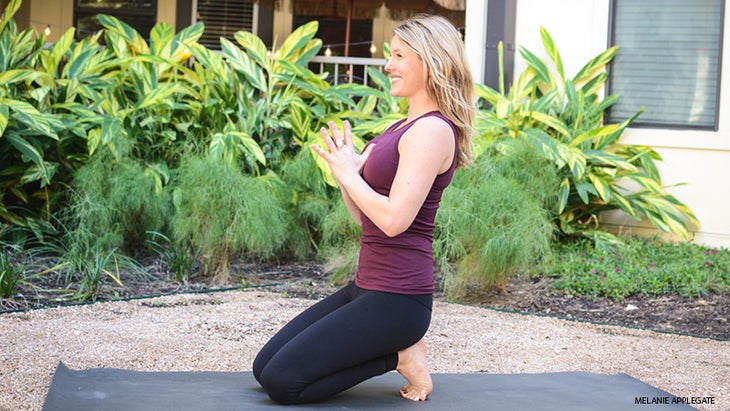
What it Does: Targets the muscles and connective tissue on the sole of the foot while stretching the deep layer of calf muscles that moves the toes and supports the arch of the foot.
How to: Come onto your hands and knees and tuck your toes under. Slowly lean the weight of your hips back and sit on your heels. To start, keep your hands on the floor in front of you and keep some of your weight on your hands as you sit back. As the pose becomes comfortable, you can progress to sitting upright with all of your weight on your heels, palms in your lap. This might be an intense stretch, but you should not feel pain. Hold for 30 to 90 seconds as you breathe easily.
Reclining Hand-to-Big-Toe Pose (Supta Padangusthasana)
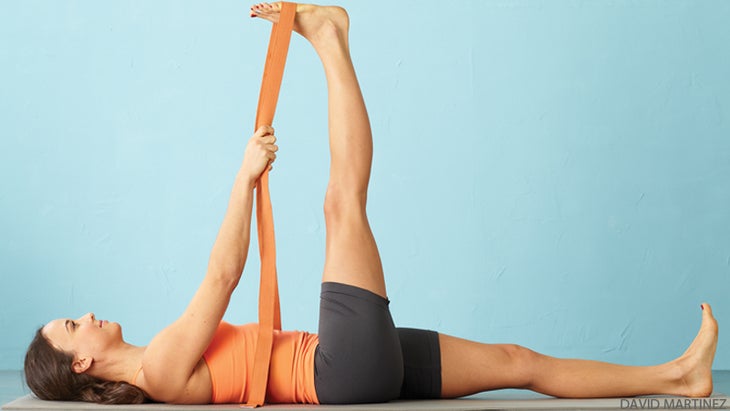
What it Does: Stretches the hamstrings and the entire line of tissue that runs along the back of the hip, thigh, and calf, which tugs on the sole of the foot when it gets tight.
How to: Lie on your back, put a strap around the ball of the right foot, and extend your right leg up. Keep your head and shoulders on the floor and grab the strap with both hands. (To make this pose easier, bend your left leg and place the sole of the foot on the ground.) You can bend the right knee if you need to, but keep your thigh close to your belly as you lightly push into the strap with the ball of your right foot. Hold for 1 to 2 minutes, and repeat on the other side.
Eye-of-the-Needle Pose (Sucirandhrasana)
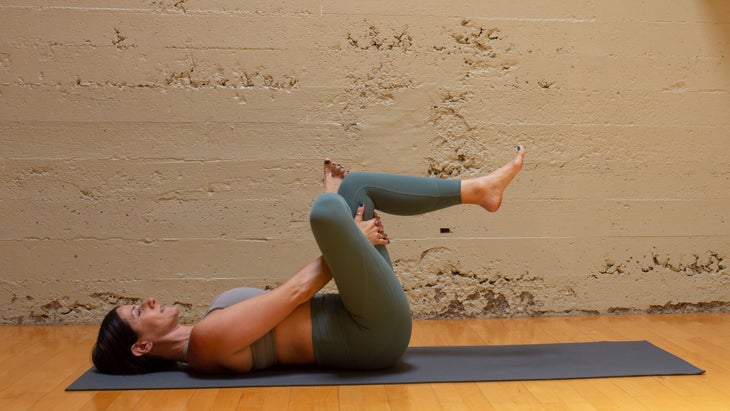
What it Does: Relieves the tight hips that are common in athletes who do a lot of running, limiting the movement of the leg muscles, putting more stress on the back of the leg, and increasing tension in the plantar fascia.
How to: Lie on the floor with both feet on the wall and your knees bent. Place the right ankle on the left knee and flex the right foot. With your right hand, gently push the right thigh, just above the knee, away from your head. Keep your hips, spine, and head on the floor and relax your neck. You can make this harder by moving closer to the wall or easier by moving farther away. To get an even deeper stretch, clasp your hands behind your left hamstring and hug it in toward your torso, with your head still on the ground. Hold for 1 to 2 minutes, and repeat on the other side.
Knees
The Injury: Iliotibial Band Syndrome
One of the most common causes of knee pain in athletes is the irritation of the iliotibial band (IT band), a thick band of fascia that runs from the top of the outer hip to just below the outer knee. It’s a common misconception that stretching the IT band itself will fix this. The band is simply a fibrous sheet; the surrounding muscles are the cause of the problem. Often, the hip muscles that attach to the IT band become tight, creating tension along the band. The IT band can also lose its ability to glide over the underlying muscles in the thigh, which inhibits knee movement. In this scenario, running or walking can create friction, causing the tissues to thicken and bind, which pulls on the knee and causes pain.
Common in: Runners, cyclists, hikers, and in soccer, basketball, and tennis players.
Symptoms: Outer knee pain that can extend behind the knee or down the outer calf, pain in the outer hip or thigh, swelling around the knee, and snapping or popping sounds with knee movement.
Poses for Prevention and Healing: The following poses stretch the muscles of the hips and thighs that pull on the IT band, and keep the band and the surrounding tissues flexible and pliable to reduce friction and injury.
Standing Forward Bend, variation (Uttanasana)
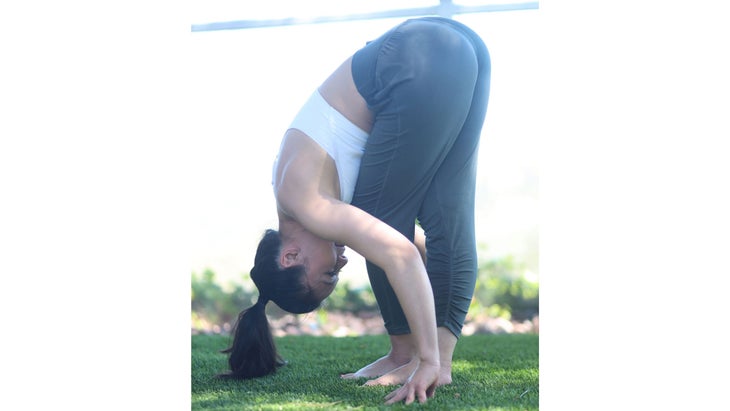
What it Does: Stretches the hamstrings where they meet the IT band
How to: Come to standing and cross your left ankle over your right. With your knees slightly bent, fold forward and rest your hands on the floor, a block, or a chair. Reach your sitting bones toward the sky and move your ribs away from your pelvis to prevent your back from rounding. Hold, breathing comfortably, for 1 minute, and then repeat, crossing your left ankle over right.
Low Lunge, variation (Anjaneyasana)
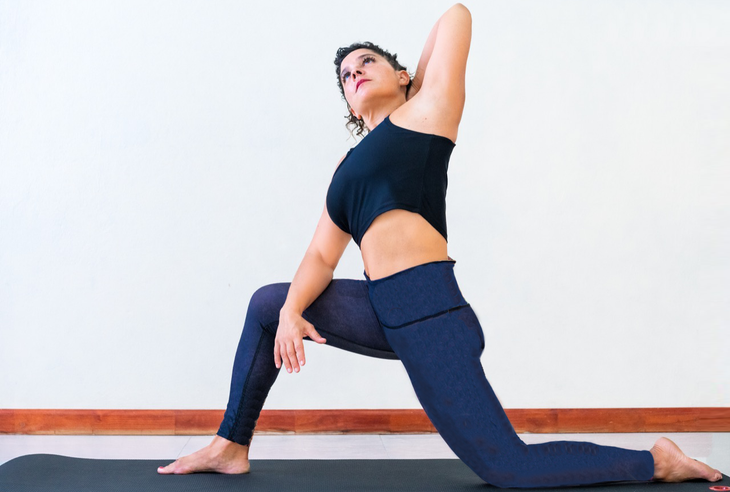
What it Does: Stretches the difficult-to-reach tensor fasciae latae at the top of the IT band.
How to: Come to a Low Lunge with your right leg forward. Lift the hips up and back until they are directly over the knee on the ground. The tendency in this pose is to lean the pelvis forward and stretch the hip flexors, but in this variation you want to keep your hips over your back knee (move your front foot back if you need to). Without over-arching the lower back, place your right hand on your right thigh and extend the left hand overhead and to the right. You should feel this in the outer hip of the left leg. Hold, breathing comfortably, for 30 to 60 seconds, and then repeat on the other side.
Supine Cow Face Pose (Supta Gomukhasana)
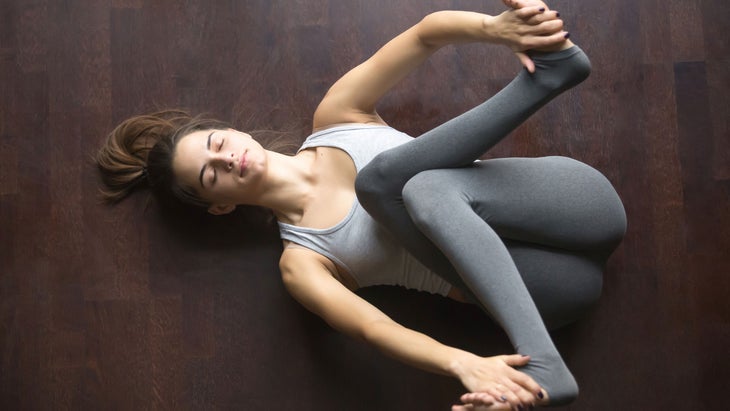
What it Does: Stretches the gluteus maximus muscles, which attach to the IT band.
How to: Lie on your back and cross one knee over the other. Keeping your head on the floor, hug your knees in toward your chest. If you feel a good stretch, stay here. If you don’t, flex your feet, grab your ankles, and pull them toward your hips. Hold for 1 minute, and then repeat with your legs crossed the other way.
Shoulders
The Injury: Rotator Cuff Inflammation or Tear
The rotator cuff is a group of four muscles that stabilizes the upper arm bone in the shoulder socket and allows the shoulder to rotate. The tendons of these muscles often become irritated, or they can be torn due to a traumatic injury or repetitive motion, especially in combination with weakness in the muscles that stabilize the shoulder blade and anchor the rotator cuff.
Common in: Swimmers, yoga practitioners, rock climbers, golfers, and tennis players.
Symptoms: Because the rotator cuff involves four muscles and their tendons, a wide range of symptoms can be associated with it. Generally, pain is felt over the top of the shoulder, but it can extend to almost anywhere around the shoulder joint itself, including the shoulder blade or the armpit.
Poses for Prevention and Healing: By strengthening the muscles around the shoulder joint and restoring range of motion to the rotator cuff, you can create a stronger, more supportive structure to move from and decrease your chance of injury—or facilitate your recovery.
Cow Face Pose, variation (Gomukhasana)
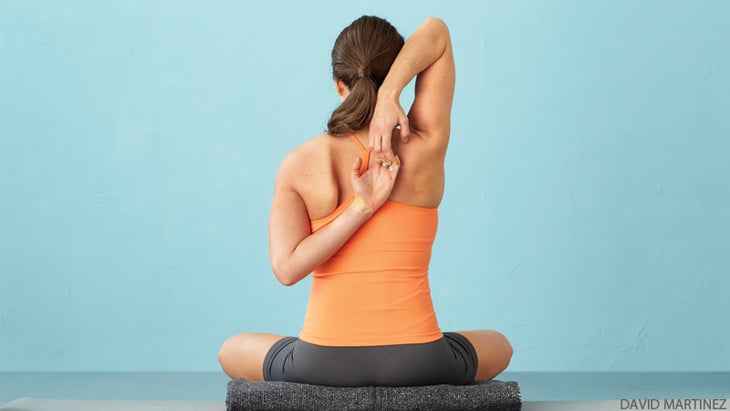
What it Does: Stretches the entire rotator cuff with a combination of internal and external rotation of the arms. (If your shoulders are tight, you can do this pose in a warm shower or grab on to a strap or towel if you can’t reach your hands.)
How to: From a seated or standing position, reach your left arm straight out to the left, parallel to the floor. Rotate your arm inwardly; the thumb will turn first toward the floor, then point toward the wall behind you, with the palm facing the ceiling. This movement will roll your left shoulder slightly up and forward, and will round your upper back. With a full exhalation, sweep the arm behind your torso and tuck the forearm in the hollow of your lower back, parallel to your waist, with the left elbow against the left side of your torso. Roll the shoulder back and down; then work the forearm up your back until it feels parallel to your spine. The back of your hand will be between your shoulder blades.
Inhale and stretch your right arm straight forward, parallel to the floor. Turn the palm up, inhale, and stretch your arm straight up toward the ceiling, palm turned back. Bend your elbow and reach down for the left hand. If you can, clasp your hands. If you can’t reach, start over with a towel or strap in your overhead hand. Hold for 1 minute, and then repeat on the other side.
Plank Pose, variation
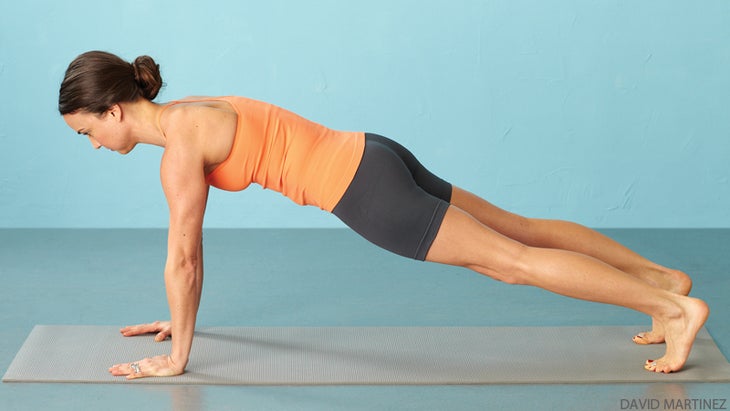
What it Does: Strengthens the muscles that stabilize the shoulder blade, which will provide a strong foundation for the rotator cuff.
How to: Come into tabletop position. As you exhale, without bending your elbows, lower your rib cage toward the floor and draw your shoulder blades toward each other. As you inhale, push the floor away, pull your rib cage away from the floor, and, without rounding the spine, spread your shoulder blades apart. Once you have the motion, come into Plank Pose and try the same movement there. Visualize your shoulder blades gliding toward and away from each other around your rib cage. Repeat 10 times, rest for a few breaths, and repeat. As your muscles grow stronger, work your way up to 15 or 20 repetitions.
Side Plank Pose, variation (Vasisthasana)
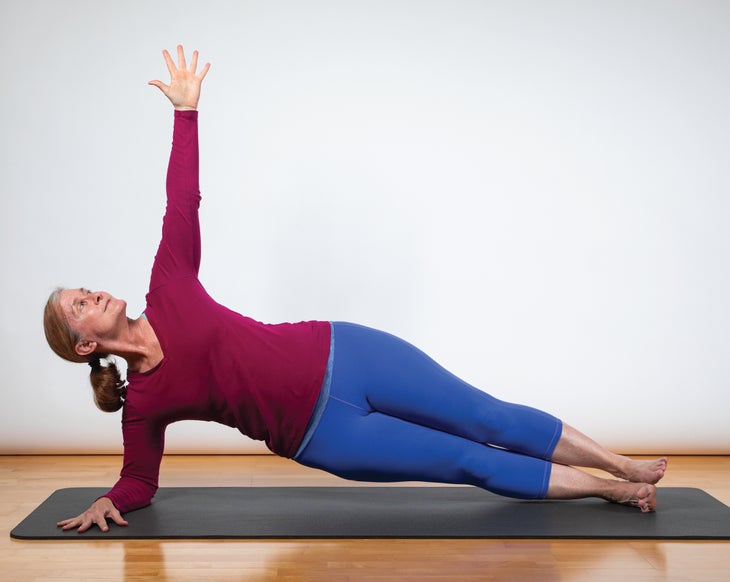
What it Does: Strengthens the muscles of the rotator cuff and teaches them to work as an integrated unit.
How to: Come onto your forearms, with your elbows under your shoulders and your feet together. Roll onto the edge of your right foot and turn your right forearm in 45 degrees. Hug your right arm bone into the socket and press the base of your right index finger into the floor. Lift and lengthen the sides of the rib cage and extend your left arm up. Hold for 30 to 60 seconds; then repeat this variation of Side Plank on the left side.
It’s All in the IT Band
Focus on hip openers as well as quadricep and hamstring stretches in your yoga practice to reduce the pull on the IT band.
Use a foam roller to release tension in the IT band. To reach the high-friction zone between the quadriceps and the IT band, imagine that your thigh is a shoe box: The outside of the thigh is one side of the box, and the front of the thigh is another side. Roll where the corner of the box would be, about halfway between the front and the outer thigh.
Relax: It’s the Best Medicine.
In yoga practice and throughout the day, focus on relaxing your shoulder blades down the back. Tension in the upper back can hike the humeral head higher in the socket and cause wear on the top of the rotator cuff.
If you sit at a computer all day, take regular stretching breaks to reduce tension in the muscles of the shoulders, neck, and chest.
Rotator cuff injuries are common among vinyasa yoga students. Ask your teacher to check your alignment in Chaturanga Dandasana and Upward-Facing Dog Pose to reduce your chance of injury.
Simple Tips for Better Performance and Fewer Injuries:
Warm Up and Cool Down. Warming up allows the blood to move into the muscles slowly so the fascia can expand to accommodate the demands of the upcoming activity. Walk for a few minutes or take a short, dynamic online yoga class aimed at pre-sport warm-ups before you train or play. Afterward, stretch for at least 20 minutes.
Soothe. Soak in a warm Epsom salt bath after exercise to relax tired muscles and absorb magnesium sulfate, which can help alleviate soreness.
Rest Easy. Muscle tissue heals and rebuilds during sleep, so don’t skimp on the shuteye, especially on hard workout days.
Mind Your Minerals. Look for a sports drink that replaces minerals (especially calcium, magnesium, and potassium) that are lost through sweat, contributing to muscle soreness and cramping. Post workout, refuel with foods high in magnesium and potassium, such as chard, kale, and cantaloupe.
Tiffany Cruikshank is the acupuncturist and yoga teacher at the Nike World Headquarters in Portland, Oregon, and is trained in sports medicine, acupuncture, and holistic health as well as in Chinese medicine.
